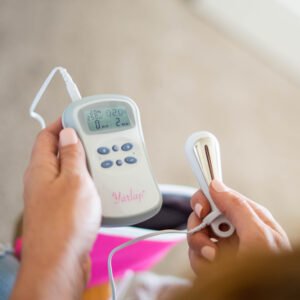Let’s talk about urinary incontinence in women.
We know… it’s not a comfortable topic. It’s often embarrassing. Some women may find that openly discussing their bladder issues makes them feel childish. After all, it’s drilled into our heads when we’re toddlers that big kids use the potty.
So even though these two circumstances are very different, our minds tend to revert to that feeling. 
The thing is — urinary incontinence in women is quite common. Far more common than you may think.
In fact, the shame and stigma surrounding urinary incontinence is a major reason you may not realize it’s so common.
If you’re starting to look into urinary incontinence because you’re concerned about the way your body is reacting to changes in your life or hormone balances, you’re in a good place. At Yarlap, we’re committed to helping women live more independent, fulfilling lives.
You shouldn’t have to be worried about your proximity to a bathroom at all times. You shouldn’t have to just “accept” that you leak every time you sneeze, laugh, or cough. You shouldn’t have to stick to black leggings because you want to hide the fact that you dribble when you go out for a run.
Here’s what you need to know about urinary incontinence — and what you can do to treat it.
Urinary Incontinence in Women: 8 Things to Know
1. What is Urinary Incontinence, Anyway?
Urinary incontinence is defined as an accidental loss of urine. It’s common for women to dislike the phrase incontinence for a variety of reasons — it makes them feel childish, they’re embarrassed, they don’t want to admit it’s really an issue, among others.
You don’t have to call it urinary incontinence if you don’t want to. We’ve heard women describe it to us as “little dribbles” or “little leaks.” If that’s the terminology you’re comfortable with, then use it.
Whether you’re experiencing little leaks or dribbles, or complete loss of bladder control, it’s important to discuss the matter with your physician. They’ll be able to assess you and determine what exactly the problem is.
If your bladder issues are caused by a weak pelvic floor, the solution may be to strengthen it. There are a few different options there, and we’ll get into it below.
2. Leaks and Dribbles are More Common Than You Think
If you’re feeling a bit embarrassed about leaks or dribbles, we hope we’re not the only ones to tell you that you’re not alone. You’re not even close to alone. In fact, more than 25 million Americans experience urinary incontinence.
According to data from the Centers for Disease Control and Prevention (CDC), about 40% of women ages 65 and older experience urinary incontinence in some form.
While it’s most common among women ages 50 and over, urinary incontinence can occur at any age for multiple reasons including pregnancy, childbirth, and menopause.
The next time you feel like the only person experiencing incontinence, remember that you’re not. Many women go through it — but they don’t necessarily talk about it.
3. There are Different Types of Urinary Incontinence
When most people think of urinary incontinence, they think of people just peeing randomly without any control. The truth is, there are some variations.
The first type is urge incontinence (also called urgency incontinence) and it’s classified as having an intense, sudden urge to urinate, followed by an inability to control it. 
It can be caused by the bladder muscles spasming, or by failure to respond to sensory triggers letting you know the bladder is full or near overflow. In this sense, frequent urination may be an indicator of urge incontinence.
The second type is stress incontinence, and it’s also the most common. Stress incontinence is characterized by leaking urine while doing activities that might put pressure on the bladder.
If the pelvic floor is weak, visceral organs move from their natural position, putting added stress on the bladder. Women most often experience stress incontinence when lifting something heavy, exercising, coughing, sneezing, or laughing.
The third is mixed incontinence, which — as the name suggests — is a combination of urge and stress.
And finally, functional incontinence is when a physical disability keeps someone from getting to a bathroom. This could be a result of many conditions, either permanent or temporary.
4. What You Eat Matters
Certain foods and beverages have a diuretic effect, which can make you feel the need to urinate. Of course, if you experience incontinence, needing to find a restroom more frequently is frustrating.
The following items may exacerbate urinary incontinence:
- Alcohol
- Caffeine
- Carbonated drinks (including sparkling water)
- Artificial sweeteners
- Chocolate
- Chili peppers
- Spicy, sugary, or acid foods, especially citrus fruits
- Too much vitamin C
5. Your Medication Could Play a Role
Some prescription medications have side effects that cause urinary incontinence or can contribute to an existing incontinence problem.
Medications with incontinence as a known side effect include some heart and blood pressure medications, sedatives, and muscle relaxants. Your doctor will be able to advise you on side effects and other things you can expect.
Of course, not all medications in these categories will contribute to incontinence, and some people may experience incontinence when it’s not a known side effect. Be sure to communicate all concerns with your physician.
6. Pelvic Floor Surgery One Treatment Option
If you haven’t asked your physician about urinary incontinence treatment yet, you may not realize that one of the options is surgery.
According to NorthWestPharmacy.com Healthcare Ambassador Dr. Brynna Connor, pelvic floor surgery involves “repair of (or to) the muscles that comprise the pelvic floor.”
We don’t need to get into the exact names of every muscle (though if you want to learn more, you can do so here). What’s important to know for this discussion is that the pelvic floor muscles are responsible for holding up the organs in that area — mainly, the uterus, bladder, and bowels.
Similar to how surgery may be required when you injure any other muscle in your body, pelvic surgery can be performed to treat urinary incontinence. Pelvic floor surgery often focuses on “the muscles that are between the bladder and vaginal area — sometimes called an anterior vaginal repair,” says Dr. Connor.
If surgery feels like a drastic step to you, you’re right. It’s major surgery with a lengthy recovery time. In many cases, pelvic floor therapy or a kegel device is a good place to start before choosing to undergo surgery.
7. Urinary Incontinence Has a Significant Environmental Impact
A major unintended consequence of “just dealing with” urinary incontinence is mostly hidden from our immediate view — the environment. 
One of the first things people try when they begin to experience incontinence is adult diapers or pantyliners designed to absorb the little dribbles. If they haven’t yet decided if (or how) they’ll treat their incontinence, absorbent diapers or pads seem like a quick, easy fix.
If a woman begins to experience urinary incontinence in her 30s, she’ll live with it for potentially 50-60 years. Assuming one pad or diaper is used per day (a conservative estimate), she’ll use upwards of 18,000 during her lifetime.
That’s a lot of extra material that will be added to landfills across the country. Of course, the major issue is that absorbent materials used to make diapers and pads are specifically designed to not break down. They take decades to biodegrade.
Babies and Boomers
In the immediate future, this presents a major problem because the largest generation of people (Baby Boomers, born between 1946 and 1964) are hitting an age where they’re more likely to experience incontinence. And this isn’t just an issue in the U.S. — after all, World War II affected everyone.
For example, Japan hit a point of urgency with the number of disposable diapers in their landfills when the number of adults using diapers surpassed the number of babies using them. They’ve found some extraordinary, innovative ways of dealing with this shift, but the U.S. lags behind them in this regard.
Some estimates place adult diaper usage as contributing to 7% of total landfill space, which is more than the contribution from babies.
Of course pads and diapers aren’t “solutions” to — or even treatments for — urinary incontinence. They’re just bandaids, essentially. Products like the Yarlap Autokegel device can effectively treat urinary incontinence and eliminate the need for pads and diapers.
8. No, You Don’t Have to Just “Accept” Urinary Incontinence
Perhaps most importantly, you don’t have to accept urinary incontinence as a regular part of your life. Many women experience leaks or dribbles after they have children. Regardless, bladder issues in women become more common with age, as the body changes, shifts, and goes through menopause.
However, that does not mean you have to learn to live with it. There are many different urinary incontinence treatment options, including weighted balls, internal devices with apps, external devices, pelvic floor surgery, and of course, the Yarlap Autokegel device. 
We’re certainly not telling you that you have to do something about the little dribbles or leaks you experience in your daily life. We’re not trying to shame you into doing something about it. If they don’t bother you, then you can just keep going about your day.
But if you’re here, reading this, the chances are good that it does bother you… at least a little bit. And if that’s the case, we want you to know that 1) you’re not alone and 2) there are urinary incontinence treatment options at your disposal — and they don’t have to involve surgery.
Why the Yarlap is the Preferred Urinary Incontinence Treatment for Millions of Women
We’ve spoken to countless women who have tried to strengthen their pelvic floor muscles on their own by doing Kegels or using various weighted balls. In some cases, they found some success, but ultimately they weren’t sure if they were even doing it correctly.
When we developed the Yarlap Autokegel device, it was important to us that it be as foolproof as possible. To that end, we use technology that would do Kegels for you.
The Yarlap device is an internal Kegel device that is FDA-cleared to treat urinary incontinence in women. This device rejuvenates your pelvic floor naturally and efficiently.
Not only is the Yarlap proven to work, but it also works quickly. In as little as two weeks, you could have better bladder control and start living a life untethered to a bathroom.
Using neuromuscular electrical stimulation (NMES), the Yarlap device contracts and relaxes the muscles of your pelvic floor for the perfect Kegel every single time. There’s no way for you to do them “incorrectly” and — thanks to the timed programs — you’ll be sure to do the recommended number of repetitions.
As if that weren’t enough, the Yarlap has the added benefit of being completely discreet. Because it’s an internal device, it remains completely hidden. No one will know you’re Yarlapping unless you tell them.
The Yarlap Autokegel® Device is Completely Discreet
The discreet nature of the device may seem too good to be true, but we can assure you it’s very real.
We’ve known executives to use them on airplanes while they’re traveling across the country for business meetings.
One of our customers (a retired senior citizen) was in need of an incontinence solution but was embarrassed to bring it up with her husband. They have a tradition of watching the nightly news together every single evening — and that’s when she Yarlaps. (Her husband still doesn’t know and this has been going on for years.)
And of course, we’ve known countless mothers (both new and seasoned veterans) who were able to use the Yarlap Autokegel device to cure their incontinence and maintain the strength of their pelvic floor moving forward.
Are You Ready to Yarlap?
If you’re ready to try our award-winning Yarlap Autokegel device, we’re more than happy to help you. You can purchase them from our website or you can call us directly at (614) 568-7000 or email us at info@yarlap.com.
In the meantime, if you have any questions, we’d love to answer them. Alternatively, you can check out our frequently asked questions page.
The sooner you get started, the sooner you can free yourself from urinary incontinence and all the stress that comes with it. We can’t wait to hear from you!
DISCLAIMER: THIS WEBSITE, YARLAP, AND RLI, INC. DO NOT PROVIDE MEDICAL ADVICE OR DIAGNOSIS.
The information, including but not limited to, text, graphics, images and other material contained on this website are for informational purposes only. Any information published on this website or by this brand is not intended as a substitute for professional medical guidance and should not be used during any medical emergency or for the diagnosis or treatment of any medical condition. Always seek the advice of your physician or other qualified health care provider with any questions you may have regarding a medical condition or treatment and before undertaking a new health care regimen, and never disregard professional medical advice or delay in seeking it because of something you have read on this website. Links to other sites are provided for information only – they do not constitute endorsements of those other sites or any recommendations or advice contained therein.



